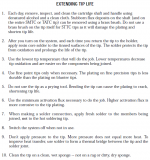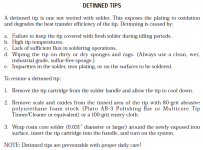Been using Weller electronic soldering station with Weller tips for maybe 10 years. I always clean the tip as follows:
Run to around 700F.
Clean thoroughly with damp sponge.
Melt a big glob of solder on the tip, making sure entire tinned surface is covered with excess.
Turn off heat.
Immediately shake off the excess onto a paper towel. Shake it hard 2-3 times. What is left is no rosin, just a thin layer of solder, still drying.
Never had a problem with a tip. The only time I have issues is when I am too harsh on my tip mechanically. They don't like to be used as screwdrivers.
Run to around 700F.
Clean thoroughly with damp sponge.
Melt a big glob of solder on the tip, making sure entire tinned surface is covered with excess.
Turn off heat.
Immediately shake off the excess onto a paper towel. Shake it hard 2-3 times. What is left is no rosin, just a thin layer of solder, still drying.
Never had a problem with a tip. The only time I have issues is when I am too harsh on my tip mechanically. They don't like to be used as screwdrivers.
Hi again,
Based on the tips I have gotten from you I have now found a way to keep my tips reasonably/quite clean:
I don't use much water on the sponge - and probably something similar to demineralized water (from my water cleaning bottle)
I don't leave the iron turned on for long after last use
I sometimes switch off the iron when there's a new drop of tin on both sides - seems to clean the tip so that when I start up the iron again it is clean on both sides.
This works fine for me - so unless others would like to share their approach I'm quite fine with matters now ;-)
Greetings & thanks,
Jesper
Based on the tips I have gotten from you I have now found a way to keep my tips reasonably/quite clean:
I don't use much water on the sponge - and probably something similar to demineralized water (from my water cleaning bottle)
I don't leave the iron turned on for long after last use
I sometimes switch off the iron when there's a new drop of tin on both sides - seems to clean the tip so that when I start up the iron again it is clean on both sides.
This works fine for me - so unless others would like to share their approach I'm quite fine with matters now ;-)
Greetings & thanks,
Jesper
I purchased a Weller SP-23, their "consumer" or hobby version of the 25W iron. The MT-series tips for these are absolute cr*p. Yes, I properly clean them (damp sponge) and try not to keep them on without use, but they will pit very quickly. I use 63/37 eutectic solder so it should not be a problem. Tips cost $7 per pair.
I now make my own soldering iron tips and they work very well. I use 3/16" brass or bronze rod from the hardware store. I thread the end using a #10-24 die, then cut to a 2" length, chuck it into a drill and sharpen the tip portion against a belt sander. It takes 10-15 minutes, saves a lot of money, and the tips have lasted significantly longer than factory ones.
The additional advantage: you're not stuck with the factory shapes. I can now make any shape or profile iron tip I want.
I now make my own soldering iron tips and they work very well. I use 3/16" brass or bronze rod from the hardware store. I thread the end using a #10-24 die, then cut to a 2" length, chuck it into a drill and sharpen the tip portion against a belt sander. It takes 10-15 minutes, saves a lot of money, and the tips have lasted significantly longer than factory ones.
The additional advantage: you're not stuck with the factory shapes. I can now make any shape or profile iron tip I want.
A note on ammonia.
Ammonia attacks copper. I'm new to electronics and still honing my soldering skills, but I'd think If you have the older copper tips or if your iron coat has worn and copper shows through, that ammonia would viciously attack the copper.
Ammonia is the main ingredient in brass polish and gun "copper fouling" solvent. Copper jacketed bullets leave behind layers of copper that must be removed after shooting, and the stuff is so strong it'll knock you on your butt (see Sweets 762 or Barnes CR-10).
Something to think about.
Ammonia attacks copper. I'm new to electronics and still honing my soldering skills, but I'd think If you have the older copper tips or if your iron coat has worn and copper shows through, that ammonia would viciously attack the copper.
Ammonia is the main ingredient in brass polish and gun "copper fouling" solvent. Copper jacketed bullets leave behind layers of copper that must be removed after shooting, and the stuff is so strong it'll knock you on your butt (see Sweets 762 or Barnes CR-10).
Something to think about.
Before I learned proper tip care and soldering technique many years ago, I was going through tips, almost as often as solder. Nowadays, the only thing to touch the tip of my iron (besides flow from heating the part and the pad, not the solder) is a well wrung sponge.
I can't remember the last time I replaced a tip - and I certainly have yet to sand on one either (at least not in the last couple of decades anyway). I'll even go as far as to frequently wipe the tip, just for the sake of keeping it "just tinned".
I can't remember the last time I replaced a tip - and I certainly have yet to sand on one either (at least not in the last couple of decades anyway). I'll even go as far as to frequently wipe the tip, just for the sake of keeping it "just tinned".
Hi all,
A follow-up on this - not necessarily to my liking, though ... It proved that the solder I used (unleaded) was the culprit of my tips disappearing very rapidly - as it was a new tip only lasted a few hours before the tip started oxidizing and declining.
I've now tried different solders - unleaded & leaded - and with the leaded one the tip lasts. It actually looks as if the tip is not really worn when I use the leaded solder, whereas with the unleaded one there quite rapidly are signs of wear (oxidation, scaling). The fact that I can use lower soldering temperatures with leaded solder probably also helps in terms of tip life span ...
I've also shifted from wet sponge cleaning of the tip to dry "sponge" cleaning. I now use a bit of steel wool to clean the tip and this appears to work perfectly. Cleans the tip completely, is low cost, easy to get, and lasts a long while (environmentally also probably not too taxing).
However, should anyone have unambiguous positive experiences with specific unleaded solders I'd appreciate hearing about it as I - when shifting solder onwards - would prefer the unleaded version if it can work well.
Cheers,
Jesper
A follow-up on this - not necessarily to my liking, though ... It proved that the solder I used (unleaded) was the culprit of my tips disappearing very rapidly - as it was a new tip only lasted a few hours before the tip started oxidizing and declining.
I've now tried different solders - unleaded & leaded - and with the leaded one the tip lasts. It actually looks as if the tip is not really worn when I use the leaded solder, whereas with the unleaded one there quite rapidly are signs of wear (oxidation, scaling). The fact that I can use lower soldering temperatures with leaded solder probably also helps in terms of tip life span ...
I've also shifted from wet sponge cleaning of the tip to dry "sponge" cleaning. I now use a bit of steel wool to clean the tip and this appears to work perfectly. Cleans the tip completely, is low cost, easy to get, and lasts a long while (environmentally also probably not too taxing).
However, should anyone have unambiguous positive experiences with specific unleaded solders I'd appreciate hearing about it as I - when shifting solder onwards - would prefer the unleaded version if it can work well.
Cheers,
Jesper
Last edited:
From the manual for a METCAL iron:
http://www.google.com/url?sa=t&rct=...voG4DQ&usg=AFQjCNFz2PZFPr--7USXpbQxWwr8Pf5ucw
Terry
http://www.google.com/url?sa=t&rct=...voG4DQ&usg=AFQjCNFz2PZFPr--7USXpbQxWwr8Pf5ucw
Terry
Attachments
Hi
I find the main reason solder iron tips go off either by gaining a coating or by lose their original coating is because solder is applied to the soldeing iron instead of to the part to be soldered.
If the tip becomes dirty I use a solder bath. This is easily formed. Initially use a few turns of solder in a small tin lid and then add any waste bits of solder to the tin to help build up a larger amount.
I find it best not to use a wet spong or sand the tip as I find that both do cause some damage. Cleaning in a solder bath or cleaning the soldering iron tip in brass wire does not seem to cause any damage.
Don
I find the main reason solder iron tips go off either by gaining a coating or by lose their original coating is because solder is applied to the soldeing iron instead of to the part to be soldered.
If the tip becomes dirty I use a solder bath. This is easily formed. Initially use a few turns of solder in a small tin lid and then add any waste bits of solder to the tin to help build up a larger amount.
I find it best not to use a wet spong or sand the tip as I find that both do cause some damage. Cleaning in a solder bath or cleaning the soldering iron tip in brass wire does not seem to cause any damage.
Don
- Status
- This old topic is closed. If you want to reopen this topic, contact a moderator using the "Report Post" button.
- Home
- Design & Build
- Equipment & Tools
- "Refurbishing" my Weller soldering tip ...

